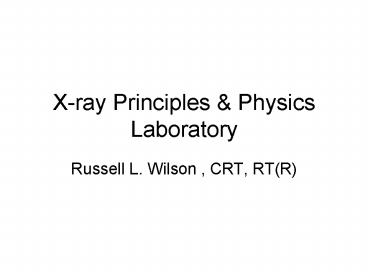X-ray Principles PowerPoint PPT Presentation
1 / 25
Title: X-ray Principles
1
X-ray Principles Physics Laboratory
- Russell L. Wilson , CRT, RT(R)
2
Properties of X-ray
- X-rays travel in a straight line and diverge from
their point of origin. - X-ray photons have many different energies.
- X-rays are highly penetrating.
- X-rays are invisible.
- X-rays travel at the speed of light.
3
Properties of X-ray
- X-rays produce scatter radiation when they
enter-act with matter. - X-rays affect radiographic and photographic film.
- X-rays cause fluorescence of some materials.
- X-rays cause biologic damage.
4
Properties of X-ray
- X-rays respond according to the inverse square
law.
5
X-ray Protection
- Because x-rays cause biologic damage, the
operator of the machine and the patient must be
protected from the radiation. - Lead is used to absorb radiation.
6
X-ray Hazards
- In the early days of radiography, the patient
often was burned by the radiation. - With proper operation of equipment, x-rays are
relatively safe today.
7
X-ray Injuries Still Occur
- These are serial photographs on a patient that
had multiple long fluoroscopic examination. - Last image is after skin graphs.
8
Patient Radiation Protection
- Later in the quarter, we will covers methods
used to keep the exposure to the patient as low
as possible. - Keeping the exposure low is the responsibility of
the operator of the x-ray machine.
9
X-ray Hazards
- With early x-ray machine, there was a real
possibility of electrocution. - Today with proper safety precautions, radiography
is very safe for the operator.
10
X-ray Hazards
- X-ray was also very hazardous for the operator in
those early years. - X-ray operators would use their hands to make
sure the machine was working .
11
X-ray Hazards
- It was not uncommon for both the operator and
patient to receive burns. - Today, with proper precautions, x-ray is safe for
the operator.
12
The X-ray Room
- The radiographic equipment consists of
- The Tube Stand, Tube Collimator
- Grid Holder or Bucky
- Controls in the Control Booth.
13
The X-ray Room
- The wall of the x-ray room and door are shielded
with lead to protect the operator and staff.
14
Operator X-ray Protection
- The Door to the X-ray Room contains lead.
- It must be closed during exposures.
15
Operator X-ray Protection
- The wall of the control booth is leaded. Stand
completely behind the wall during exposures.
16
Operator X-ray Protection
- Observe the patient or experiment through the
lead glass window. No peeking around the wall!
17
X-ray Tube
- X-rays are produced inside the x-ray tube.
- Many properties of light and x-ray are the same.
18
Modern X-ray Tube
- This is a modern rotating anode general
- radiographic x-ray tube.
- The leaded glass holds the vacuum in the tube.
- Anode rotated to cool tube.
19
X-ray Collimator
- Using light in the collimator, lead shutters are
moved to restrict the area of exposure.
20
X-ray Collimator
- Collimation is our best tool for reducing
radiation exposure to the patient.
21
Observations
- 1. Did the light field match the x-ray beam? Yes
- 2. What principle did this demonstrate? X-ray
s travel in a straight line line and diverge from
the point of origin. X-rays have similar
properties to light.
22
Observations
- 3. Did the intensity of the fluorescence of the
screen change when the kVp was increased? Yes - 4. Would this indicate that the intensity of the
beam changed? Yes - 5. During the exposure could you see inside the
phantom? Yes
23
Observations
- 6. What property of x-ray did this demonstrate?
X-rays are highly penetrating. - 7.After the tone from the control terminated, did
the screen continue to fluoresce? No - 8.If the screen did not fluoresce, was there any
radiation coming from the tube after the tone
stopped? No
24
Observations
- 9. Did you hear any noise coming from the tube
after the tone stopped? Yes the rotor continued
to rotate. - 10. What did you see on the film that was sitting
near the phantom? A blurry image. - 11. What principle did this demonstrate? X-rays
produce scatter radiation. Scatter radiation is
not divergent.
25
The End
- Return to Lectures Home Page

